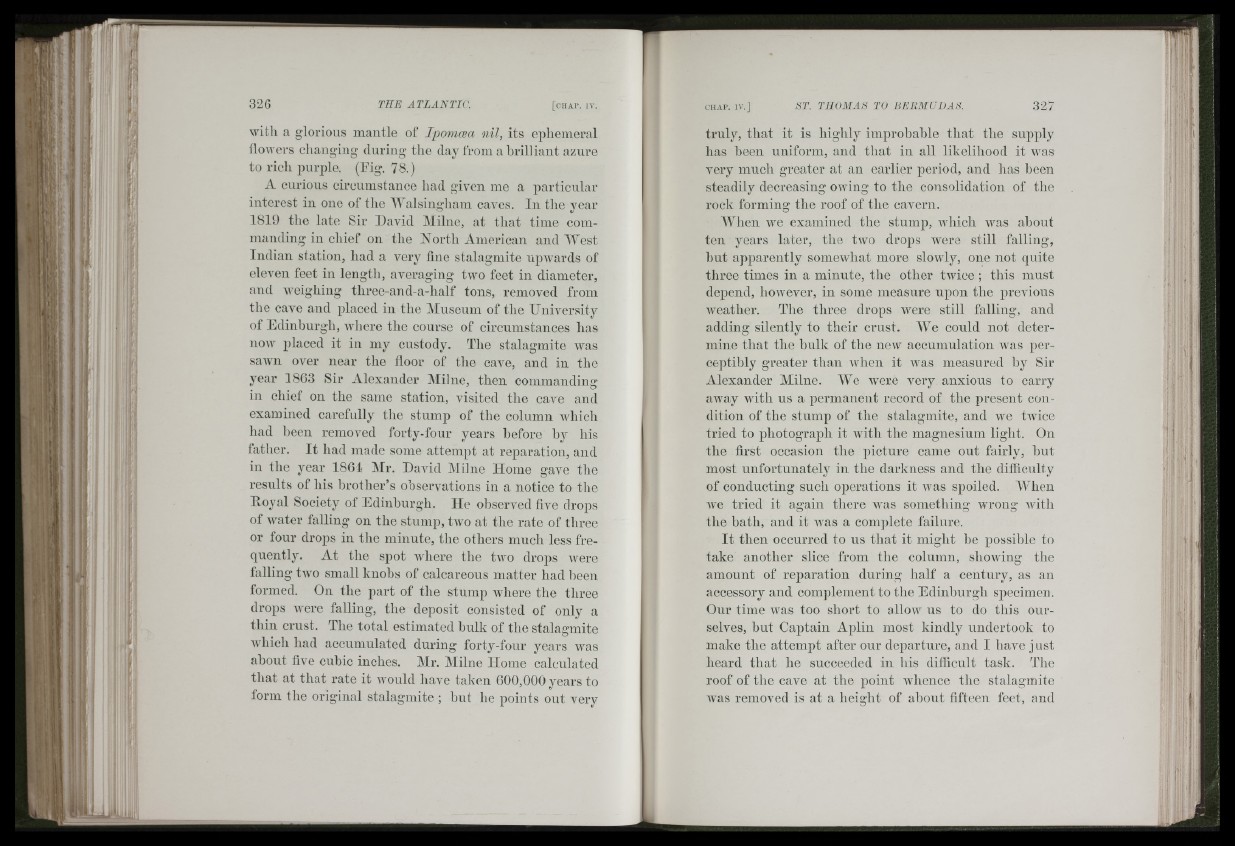
witli a glorious mantle of Ipomcea nil, its ephemeral
flowers changing during the day from a brilliant azure
to rich purple. (Pig. 78.)
A curious circumstance had given me a particular
interest in one of the Walsingham caA'es. In the year
1819 the late Sir David Milne, at that time commanding
in chief on the North American and "West
Indian station, had a very fine stalagmite upwards of
eleven feet in length, averaging two feet in diameter,
and AA'eighing three-and-a-half tons, removed from
the cave and placed in the Museum of the University
of Edinburgh, Avhere the course of circumstances has
now placed it in my custody. The stalagmite was
saAvn over near the floor of the cave, and in the
year 1863 Sir Alexander Milne, then commanding
in chief on the same station, visited the cave and
examined carefully the stump of the column Avhich
had heen removed forty-four years before hy his
father. It had made some attempt at reparation, and
in the year 1861 Mr. David Milne Home gar'e the
results of his brother’s observations in a notice to the
Hoyal Society of Edinhurgh. He observed five drops
of Avater falling on the stump, tAA'o at the rate of three
or four drops in the minute, the others much less frequently.
At the spot Avhere the tAvo drops were
falling tAvo small knobs of calcareous matter had heen
formed. On the part of the stump where the tliree
drops AA'ere falling, the deposit consisted of only a
thin crust. The total estimated hulk of the stalagmite
AA'hich had accumulated during forty-four years was
about five cubic inches. Mr. Milne Home calculated
that at that rate it Avould have taken 600,000 years to
form the original stalagmite ; hut he points out very
truly, that it is highly improbable that the supply
has heen uniform, and that in all likelihood it Avas
very mucli greater at an earlier period, and has been
steadily decreasing owing to the consolidation of the
rock forming the roof of the cavern.
'When Ave examined the stump, Avhicli was ahout
ten years later, the two drops Avere still falling,
hut apparently someAvhat more slowly, one not quite
three times in a minute, the other tAvice ; this must
depend, hoAvever, in some measure npon the previous
Aveather. The three drops were still falling, and
adding silently to their crust. W"e could not determine
tliat the hulk of tlie new accumulation AA'as perceptibly
greater than Avhen it Avas measured hy Sir
Alexander Milne. We Avere very anxious to carry
away Avith us a permanent record of the present condition
of the stump of the stalagmite, and we tAvice
tried to photograph it Avith the magnesium light. On
the first occasion the picture came out fairly, hut
most unfortunately in the darkness and the difficulty
of conducting such operations it Avas spoiled. W^hen
Ave tried it again there Avas something wrong Avitli
the hath, and it Avas a complete failure.
It then occurred to us that it might he possible to
take another slice from the column, showing the
amount of reparation during half a century, as an
accessory and complement to the Edinburgh specimen.
Our time Avas too short to allow us to do this ourselves,
but Captain Aplin most kindly undertook to
make the attempt after our departure, and I have just
heard that he succeeded in his difficult task. The
roof of the cave at the point Avhence the stalagmite
Avas removed is at a height of about fifteen feet, and
■ r fiii'
: ' II
i l